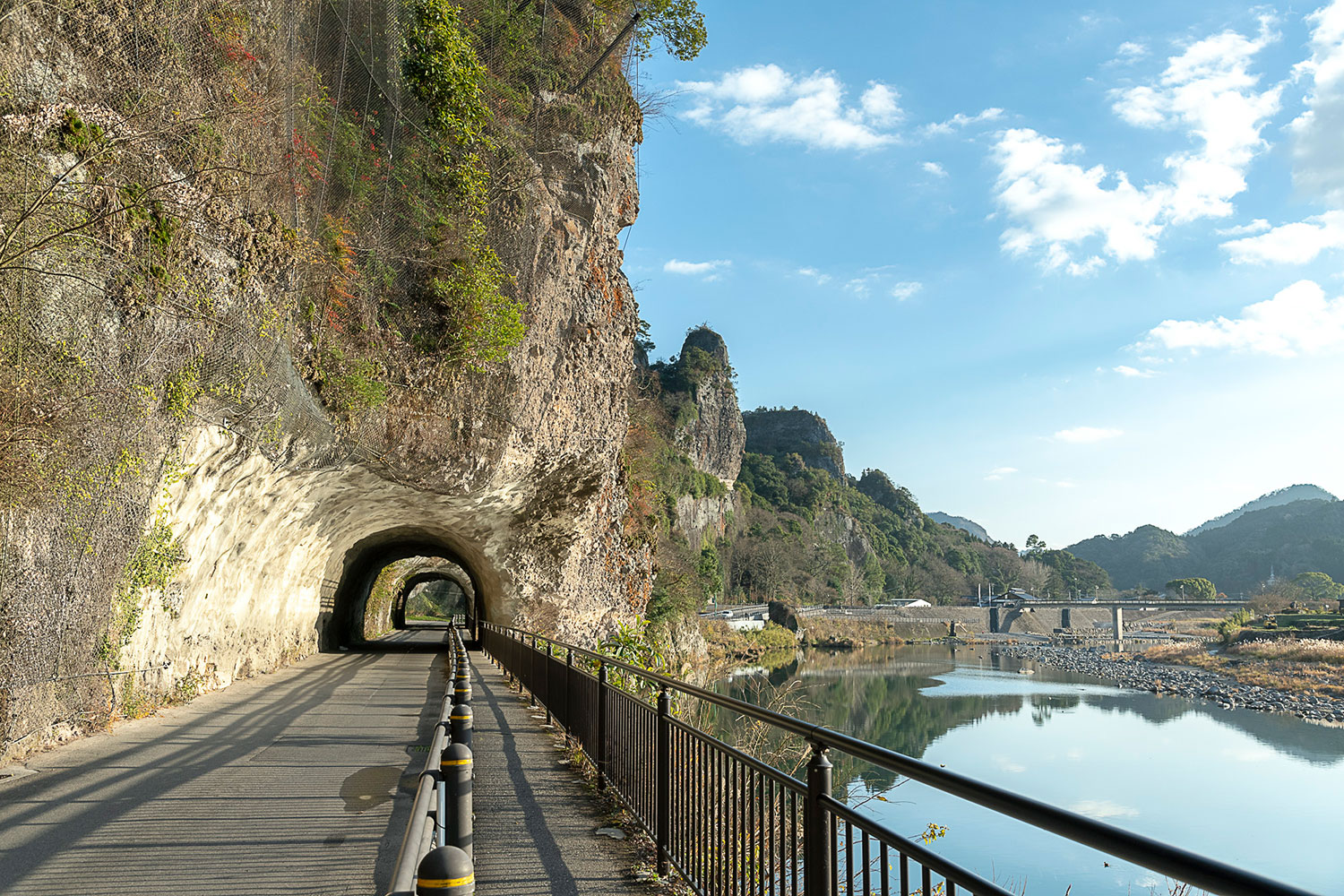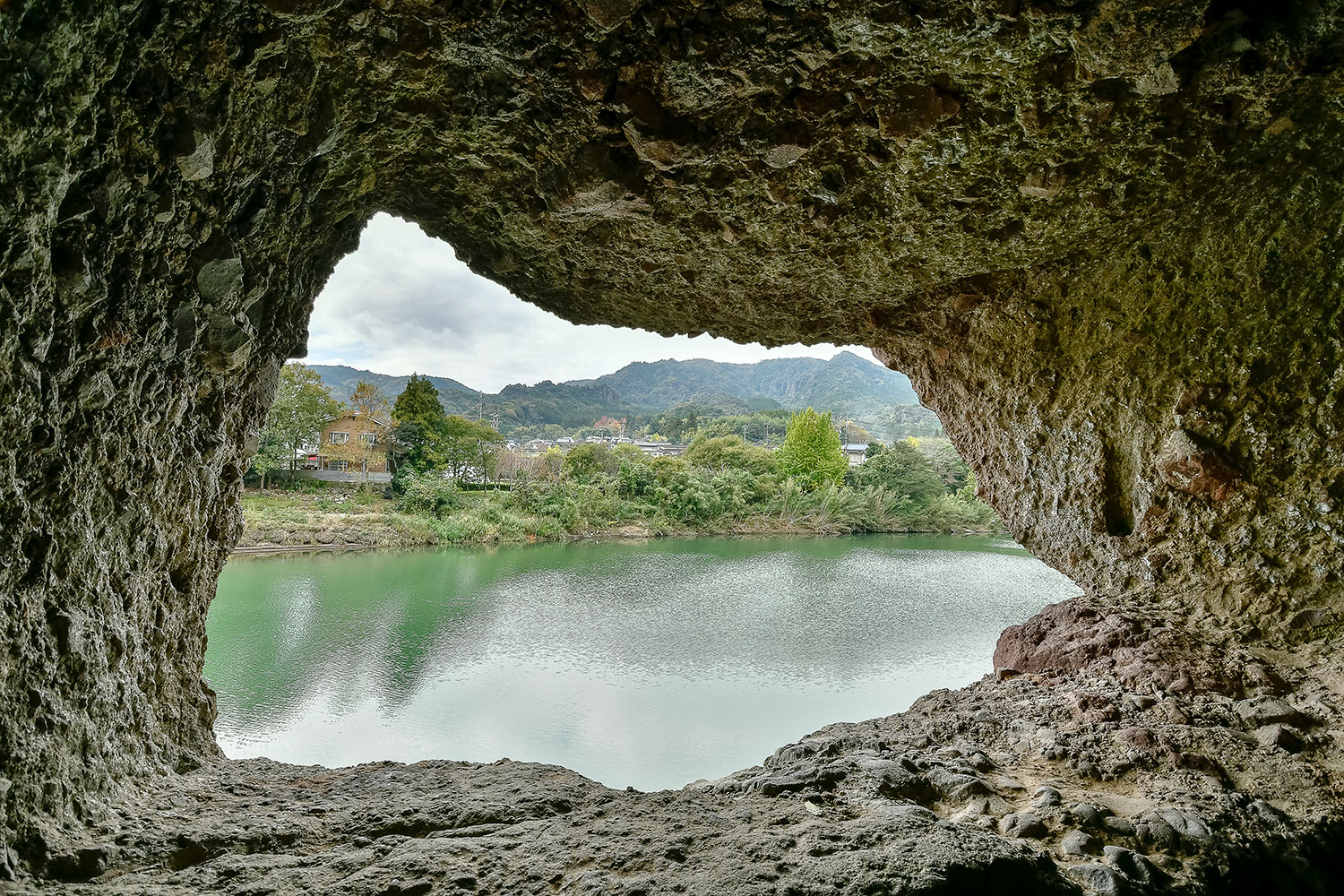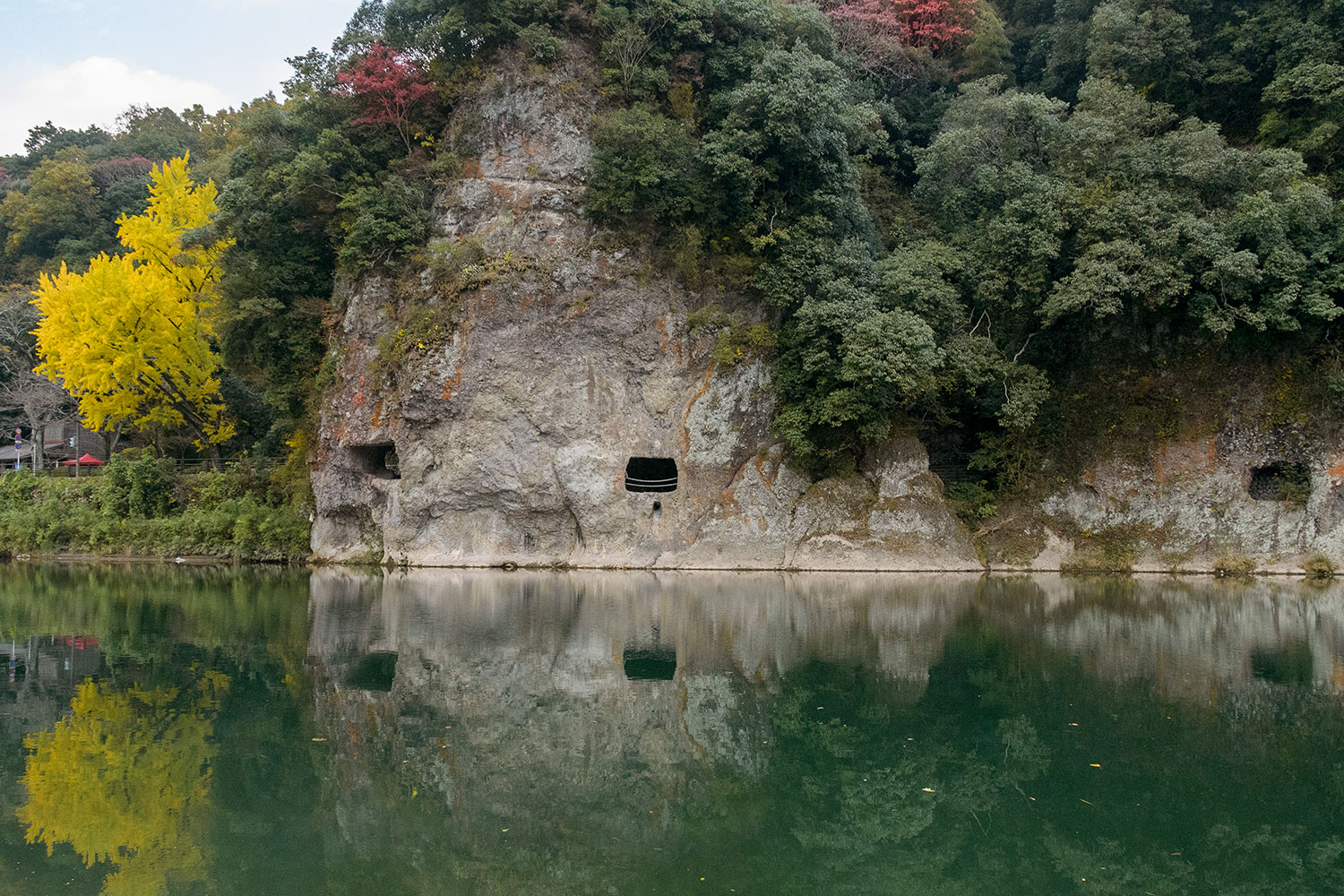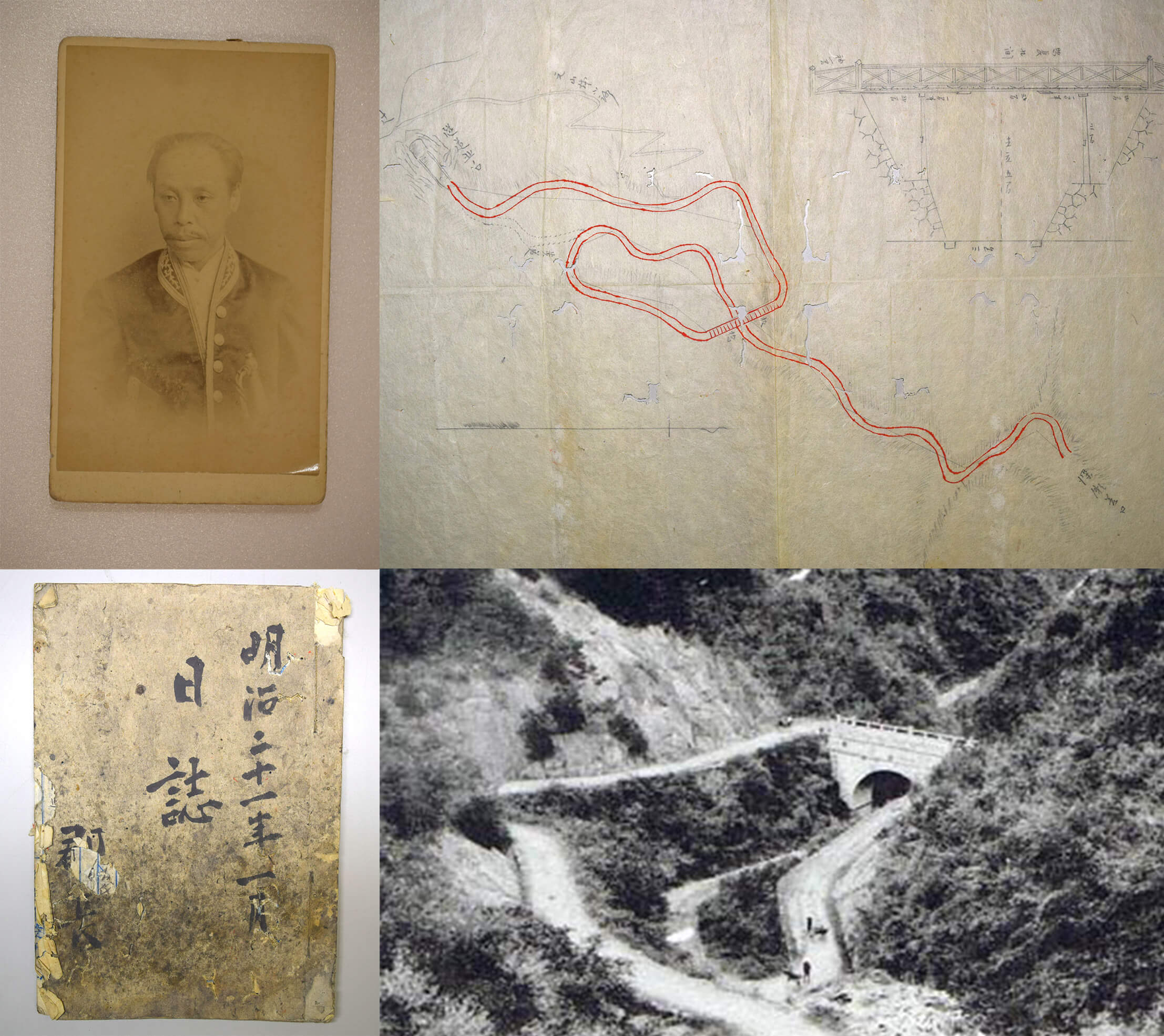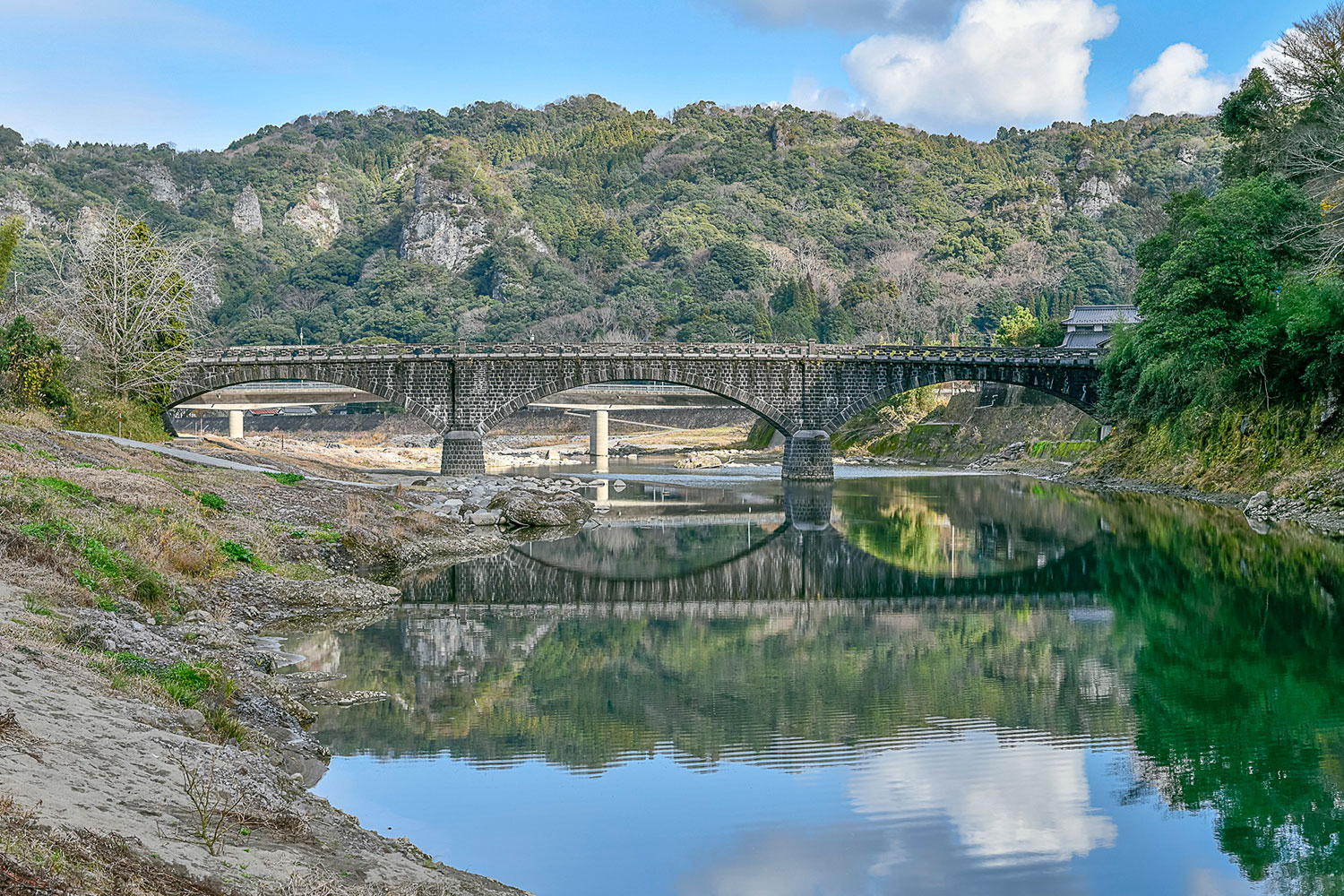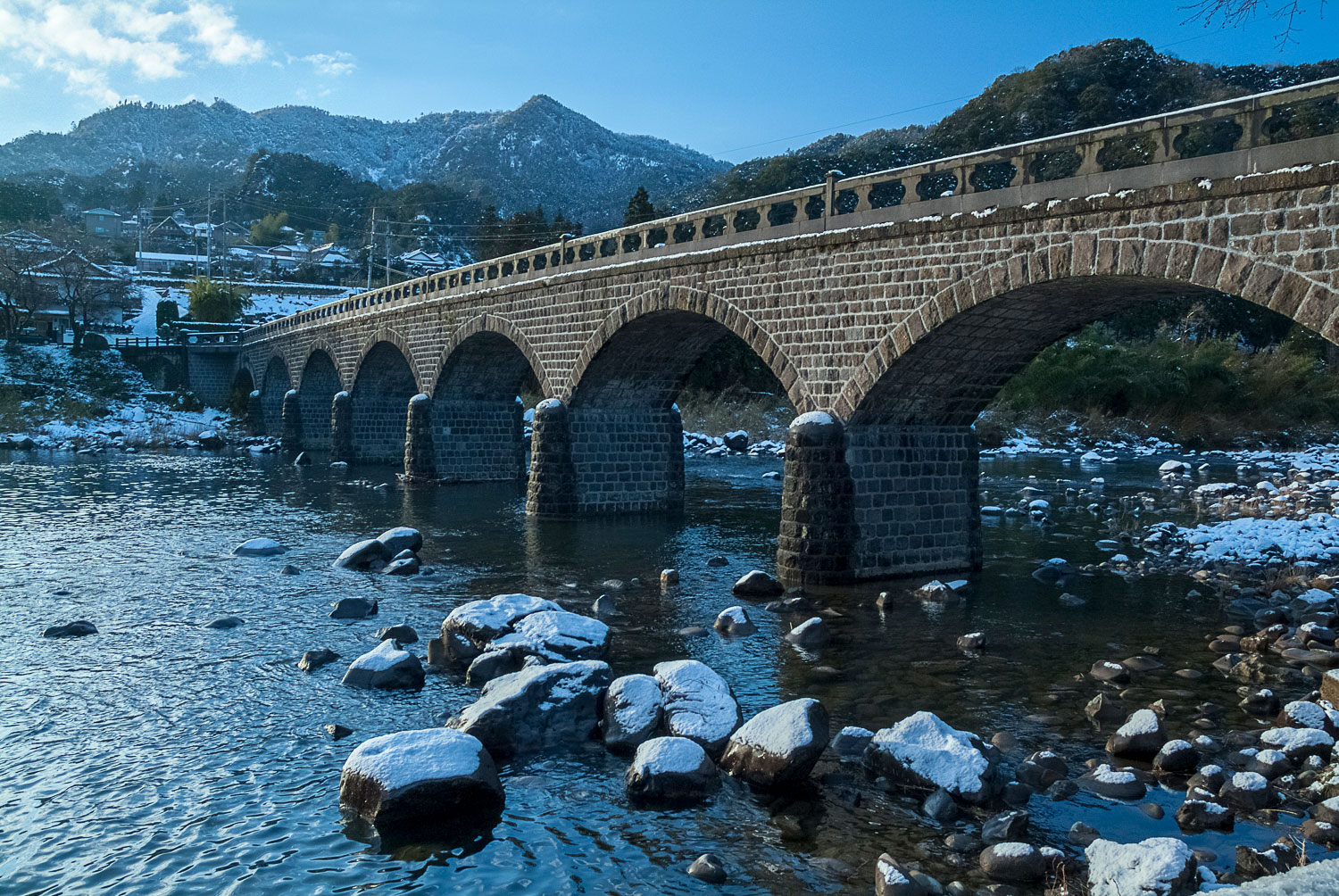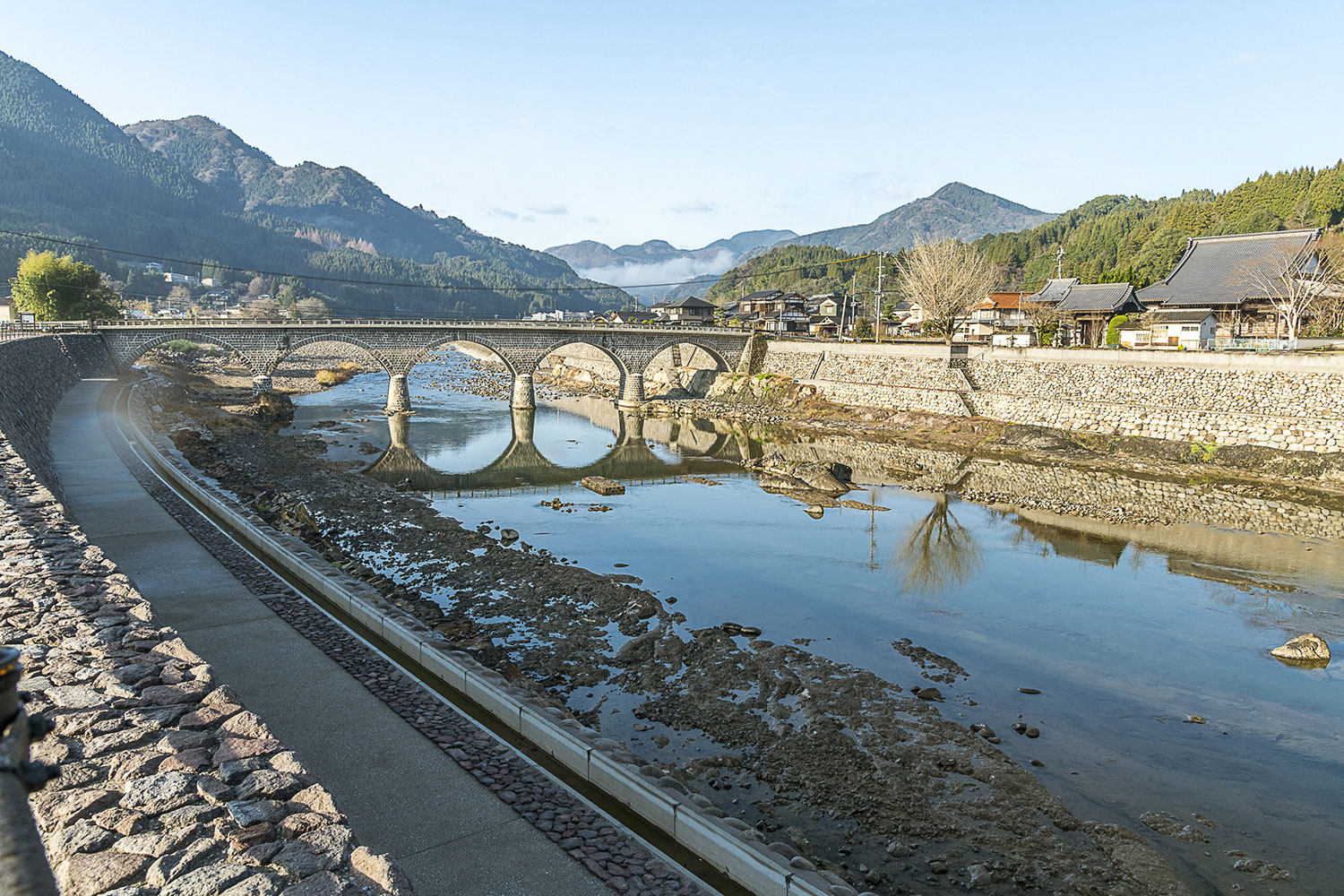その地形ゆえ、時に耶馬渓の自然は人々の生活を苦しめます。そびえる断崖、急峻な渓谷、氾濫する川の流れ。厳しい神の領域に果敢に立ち向かった男たちがいました。彼らは自身の財産や人生の時間を捧げて、トンネルや道や橋を通し、人々を救ったのです。
岩窓からの眺めー青の洞門ー
手掘りの岩窓が並ぶー青の洞門ー
江戸時代中頃、五百羅漢に憧れ江戸からやってきた禅海和尚。羅漢寺参りの人々が断崖にかけられた桟橋から落ち命を落としていることを知りました。和尚は地域を巡って出資者を募り、集った資金で石工たちを雇い、洞門を掘り始めます。「人は四文、馬は八文」。通行料もとりつつ資金にあてた工事は、まさに有料道路。
そして、岸壁に槌(つち)をふるい鑿(のみ)をうちつけること30年。ついに明かり取りの窓が川面に影を落とす「青の洞門」が完成しました。岩窓から差し込む光、浮かびあがる無数の鑿痕。和尚の苦労は人々を助け、耶馬渓観光の一助となったのです。
今はなきループ橋と村上医家史料館に残る資料
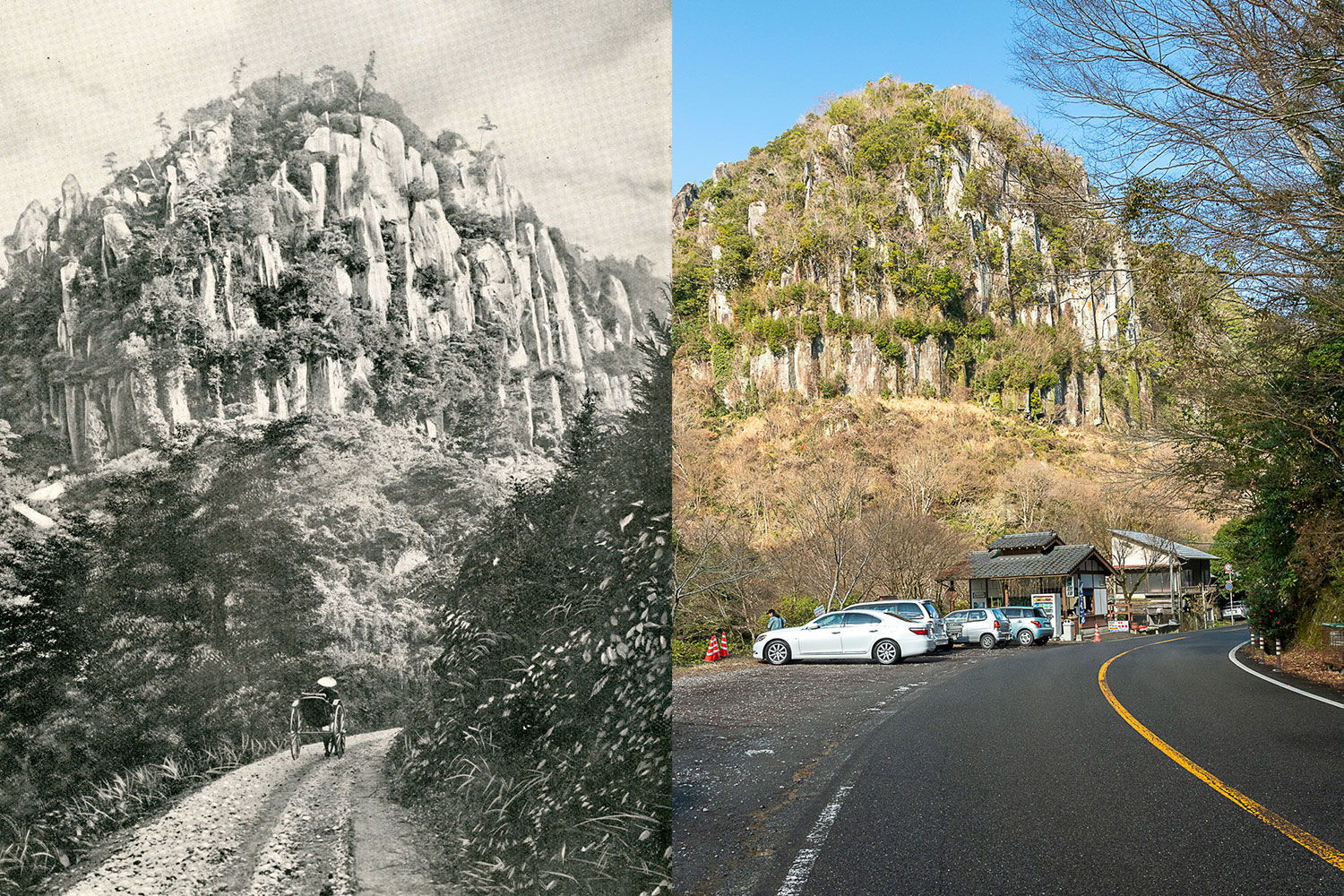
中津と玖珠をつなぐ道、開通当時と現在
明治時代、玖珠郡長(※1)となった村上田長は、山に囲まれた玖珠の発展を願い、海辺の中津と山の玖珠をつなぐ道をつくることを決意しました。自ら測量をし、地主の説得を行った田長。岩山や急峻な勾配にも苦しめられ工事は難航しましたが、ループ橋を考案するなど工夫を重ね遂に道路は完成しました。険しい渓谷を切り開くと、秘境「深耶馬渓」がその姿をあらわしたのです。頼山陽も見ることのなかった渓谷は「天下の勝地」と呼ばれるようになりました。
谷々の水が集る山国川。ひとたび大雨が降れば木の橋は流され、「対岸に嫁にやれば親の死に目に会えぬ」と言われるほどの急流となります。人々を救ったのは、大正時代に次々とかけられた石橋でした。
日本唯一の8連アーチの耶馬渓橋は、長さも日本一を誇っています。川をせきとめる橋脚の面積を減少させるため、アーチを極限まで扁平にさせた羅漢寺橋は現代の河川の基準さえクリアしています。
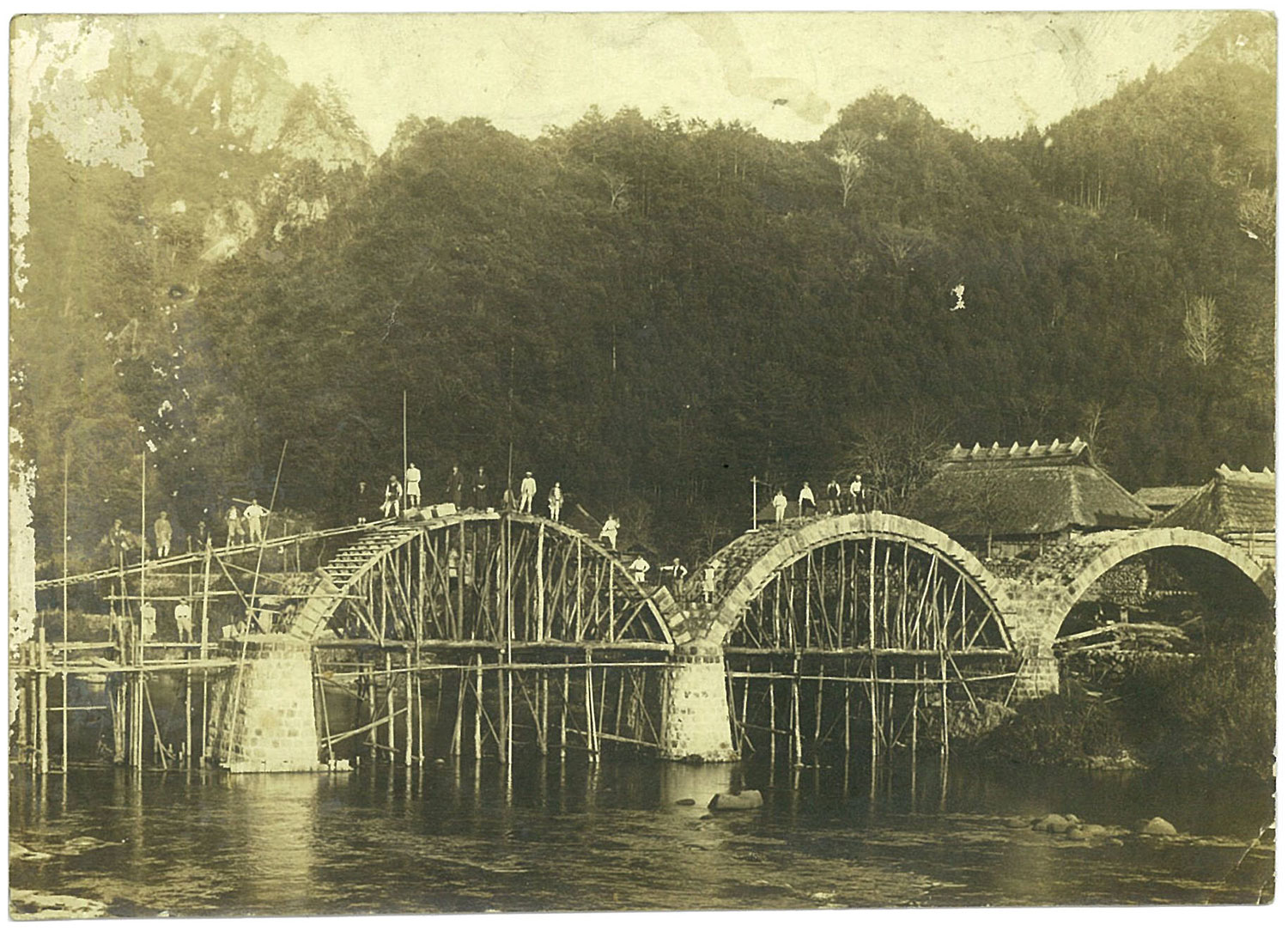
架橋中の石橋ー馬溪橋ー
蛇行する川の流れは時に石橋すらも押し流します。石工・甲斐伊蔵は「どんな洪水にも流されない恒久橋をつくる」と決意しました。彼は潜水夫を雇い、水中の岩盤を掘削し、橋脚の基礎を据えました。潜水夫の命を左右する空気ポンプは、伊蔵自らが操作しました。決死の工事で生まれた馬渓橋。橋は幾多の洪水を乗り越え、激流に立ち、伊蔵の魂を伝えています。
※1:玖珠郡長(くすぐんちょう)=玖珠郡に置かれた郡役所の長官。当時は府県と町村の間の行政として郡制が引かれていた。
Next story
Other content
Creating Roads. Raising Bridges.
Ao-no-Domon (Carved Tunnel of Ao)
The nature of Yabakei sometimes troubles the lives of the people there due to its terrain—towering cliffs, steep
valleys, the flow of flooding rivers. There was a group of men who stood resolutely in this realm of stern gods. They
gave up their fortunes, their lives, and their time to create tunnels, roads, and bridges to help the people of the
area.
View From a Stone Window – Ao-no-Domon (Carved Tunnel of Ao) –
Hand-Carved Stone Windows in a Row – Ao-no-Domon (Carved Tunnel of Ao) –
Around the middle of the Edo Period, Zenkai Osho came here attracted by the Gohyaku-Rakan. He learned that people coming to visit Rakanji Temple were falling from the bridges hung from the steep cliffs there and losing their lives. He then went around the area recruiting investors and, with the funds he was able to raise, hired stonemasons to begin carving out a tunnel. “Four mon per person, eight mon per horse.” The construction, which was partially funded by these sort of tolls as well, was truly a toll road.
After 30 years of striking the cliff surface with hammer and chisel, the Ao-no-Domon (Carved Tunnel of Ao), whose skylight windows cast shadows on the river surface, was completed. The light shining in through the stone windows, the innumerable chisel marks which stand out on the cliff face—Osho’s hard work saved the people of the area and contributed to Yabakei sightseeing.
The
Now-Defunct Loop Bridge and Documents Remaining in the Doctor Murakami Family Museum

Connecting Nakatsu and Kusu: At Its Opening and At Present
During the Meiji Period, Murakami Dencho, who became the Kusuguncho (*1), resolved to open a road connecting the seaside area of Nakatsu with the mountainous area of Kusu in hopes that it would bring about development for Kusu, which was surrounded by mountains. Dencho did the surveying and persuaded the local landowners himself. The construction, plagued by rocky mountains and steep inclines, was a difficult undertaking. However, with the planning of a loop bridge and numerous other such solutions, the road was eventually finished. After clearing through the rugged valleys, the secluded region of Shin-Yabakei appeared. The ravine, which even Rai Sanyo never got to set eyes on, came to be called “Tenka-no-Shouchi” (one of the most beautiful sceneries in all the world).
kanji Bridge
Yabakei Bridge
The Yamakuni River, where water from the surrounding valleys gathers—when heavy rain would fall for a time, the wooden bridges would get washed away, and the river itself would change to rapids so fierce that people would say “If you give your daughter away in marriage to the opposite shore, she won’t be able to experience her parents’ deaths.” The stone bridges built one after the other in the Taisho Period are what saved the people here. Yabakei Bridge, Japan’s only bridge with 8 successive arches, also holds the honor of being the longest of its kind in Japan. Rakanji Bridge, whose arches were made as flat as possible in order to decrease the surface area of the bridge supports which dam up the river, can even pass modern river criteria.

A Stone Bridge Among Bridges – Bakei Bridge –
Bakei Bridge
The meandering flow of the rivers sometimes even washes away stone bridges. The stonemason Izou Kai resolved to build a “permanent bridge that would never be washed away by any sort of flood.” He hired divers to excavate underwater bedrock and laid down the foundations for the bridge supports. Izou himself controlled the air pump which determined whether the divers lived or died. Bakei Bridge was born from the do-or-die spirit of this construction work. The bridge has withstood numerous floods and stood against the rapids to pass down Izou’s spirit.
*1: Kusuguncho – The head of the county offices in Kusu-gun. At the time, the county (gun) system was set up as an
administrative system between the prefectural and town and village administrations.
Next story
> episode 6 Protecting and Passing Down Yabakei
Other content

